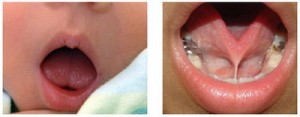Any irregularities of the tongue may affect the movement of the organ, which can result in speech or feeding difficulties. The most common problem affecting the tongue is tongue tie or medically known as ankyloglossia. It can occur with different degree of severity which may or may not be related to functional disability of the tongue. Some children or babies have no problems with eating or drinking while some others do.
What is Tongue-tie?
Tongue tie is a condition in which the lingual frenum (or lingual frenulum) is either too short or placed too front which limits the movement of the tongue. The lingual frenum is the thin cord-like tissue that attaches the tongue to the floor of the mouth. Tongue tie can occur in about 3 to 5% of infants at birth and in 13% of infants with breastfeeding problems.
Tongue tie can run in the family. There are reports of tongue tie affecting several generations of a family which may suggest a possible genetic basis for the condition. Tongue tie also sometimes occurs together with certain syndromes such as cleft lip and palate, ankyloglossum superious syndrome Rainbow’s syndrome, Fraser’s syndrome and orofacial digital syndrome.
The appearance of tongue tie is not the same in each person. They can vary in appearance – the tongue tip can be heart-shaped or V-shaped, the lingual frenum can be short or thick and other variations. Furthermore a tongue tie infant will look different than an older child or adult with the same condition.
What are the types of tongue-tie?
Different clinicians have their own way of classifying tongue tie. A pediatric dentist may use a different classification than of a lactation consultant. One textbook classification divides the tongue tie condition as follows:
- Partial tongue tie – the lingual frenum changes the appearance or function of the baby’s tongue because of the short length, lack of elasticity or attachment too far back beneath the tongue or too close to or onto the gums.
- Complete or True Tongue tie – whereby there is extensive fusion of tongue to the floor of the mouth, which is extremely rare.
Symptoms of tongue-tie
Tongue tie babies may have the following symptoms:
- Heart-shaped tongue tip
- Square or rounded tip of the tongue
- Limited movement of the tongue
- Tongue does not extend out properly
- Recurrent tongue biting
- Frenum is attached very close to the tip of the tongue
- Poor latching on to mother’s nipple when breastfeeding
- Poor sucking of breast milk
- Shows no weight gain
How does tongue-tie affect breastfeeding?
At birth a baby’s tongue is able to extend pass the gums in the front. An abnormally short or tight tongue restricts the proper extension and elevation of the baby’s tongue which therefore alter the normal movement of the tongue during feeding. Breastfeeding tongue tie babies can result in potential nipple trauma and problems with effective milk transfer to the baby, causing the baby difficulty in gaining weight.
How to diagnose tongue-tie
All newborn babies, whether healthy or ill, should undergo a thorough examination of the mouth to check for normal functioning and development. You dentist or doctor will physically exam your baby by checking the appearance of the tongue and frenum or by using a scoring system to confirm the diagnosis of tongue tie.
Your doctor may ask the parent about any maternal nipple trauma and examine the nipple area. The mother might experience traumatized nipple, severe pain when breastfeeding or any breast discomfort if the baby is tongue tied.
Furthermore the baby will be weighed and the rate of weight gain since birth accessed. Your doctor might need to observe the mother and baby while breastfeeding to access the effectiveness of feeding and provide assistance as appropriate. Problems including inability to latch onto nipple and ineffective feeding could be spotted.
Other tongue-tie complications
Short and long term complications of tongue tie may include, besides feeding difficulties; speech, orthodontic and psychological problems.
Some of the possible complications that may occur are:
- Difficulty in feeding as they grow up due to poor tongue movement and chewing, and persistent messy eating
- Slower than normal speech rate
- Reduced speech precision during shouting
- Distortion of certain speech sounds due to limitation of tongue tip elevation
Treatment for tongue-tie
Simple management of tongue tie may be sufficient which include physical education, breastfeeding assistance, parental education and reassurance. Tongue tie can be corrected surgically by snipping the lingual frenum in a procedure called frenectomy, frenuloplasty or frenulotomy.
Tongue tie operation is indicated if:
- complete fusion of tongue is present
- when nursing and feeding become a problem
- child is between 2 to 4 years of age, with poor development of speech and anxious parents desire for the necessary treatment
- in cases where tongue tie has recurred after snipping
If tongue tie release is required, the procedure should be performed by an experienced pedodontist or physician or be referred to an oral surgeon. Tongue tie surgery may seem like a minor procedure but there might be complications from the surgery whereby careless cutting of the frenum in a newborn can cause bleeding and the tongue may become too mobile and may be swallowed, causing suffocation. Furthermore there is also possibility of a subsequent infection at the base of the tongue, with formation of large ulcer and spreading inflammation of the mouth issues.




